Part II Measures for Each Priority Issue
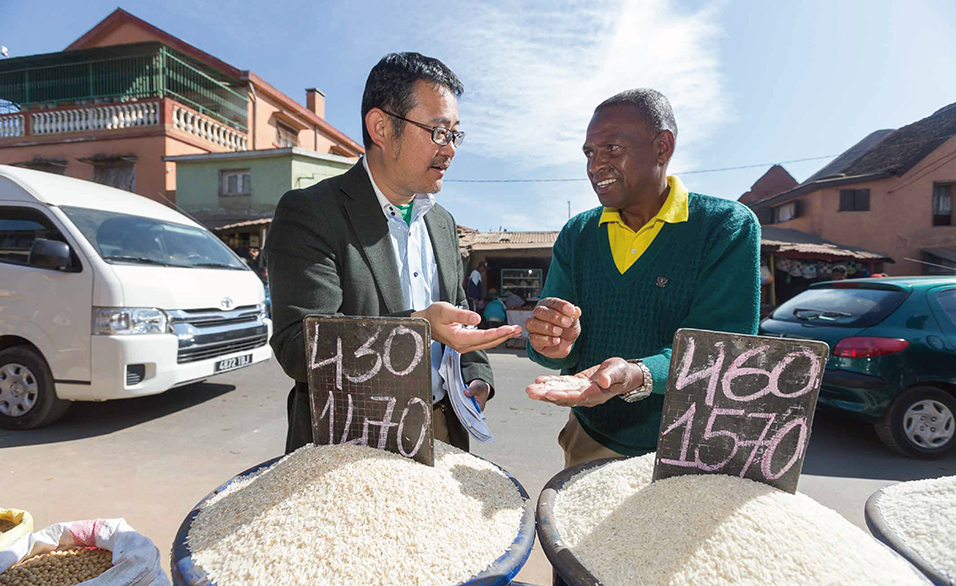
A JICA expert conducting market research on rice under the technical cooperation “Project for Rice Productivity Improvement and Management of Watershed and Irrigated Area (Phase 2)” in Madagascar (Photo: KUNO Shinichi/JICA)
1 Cooperation Aimed at Achieving “Quality Growth”
(1) Development of Industrial Infrastructure and Industries and Economic Policy
In order to achieve “quality growth,” Note 1 it is important to improve the socio-economic infrastructure that serves as the foundation for development. Moreover, it is crucial that the private sector plays a key role, and it is indispensable to boost private sector activities, such as the development of industries and the expansion of trade and investment. In developing countries, however, it can sometimes be difficult to develop capacities or set in place an environment for promoting trade and attracting private investment. Thus, support from the international community is required.
● Japan’s Efforts
■ Quality Infrastructure
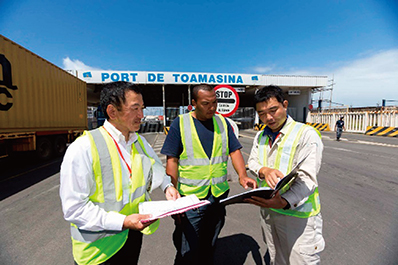
Toamasina Autonomous Port staff and Japanese experts discussing truck traffic routes at Toamasina Port in Madagascar, which is being expanded with a Japanese ODA loan (Photo: KUNO Shinichi/JICA)
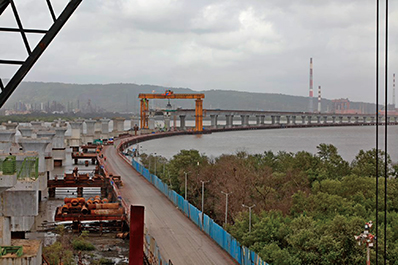
Construction site of the Mumbai Trans Harbour Link, the longest bridge in India (Photo: Mumbai Metropolitan Region Development Authority)
Developing countries continue to have an enormous demand for infrastructure. It is forecasted that the infrastructure supply and demand gap by 2040 is approximately $15 trillion. Note 2 However, in order to achieve “quality growth” in developing countries, it is necessary not only to develop a large amount of infrastructure, but also to develop “quality infrastructure”* that takes into account transparency, openness, economic efficiency in view of life-cycle cost, and debt sustainability, etc.
Japan develops “quality infrastructure” in line with the economic and development strategies of developing countries and trains human resources to maintain and operate the infrastructure. Japan’s strength lies in helping develop infrastructure that is truly contributory to “quality growth” in developing countries, which also includes technology transfer and job creation.
Japan cooperates with various countries and international organizations to promote and implement the “G20 Principles for Quality Infrastructure Investment,” Note 3 which were endorsed at the 2019 Osaka Summit. The importance of “quality infrastructure investment” has been confirmed at various bilateral and multilateral meetings.
At the G20 Rome Summit in October 2021, Prime Minister Kishida stressed that it is necessary to implement “quality infrastructure investment” in accordance with the G20 Principles for the recovery of the global economy. The Leaders’ Declaration recognized the critical role of quality infrastructure investments in the recovery phase and affirmed that the G20 would continue to advance the work related to the G20 Principles for Quality Infrastructure Investment.
At the ASEAN-Japan Summit Meeting in November 2020, Japan launched the “Japan-ASEAN Connectivity Initiative” with a focus on quality infrastructure projects worth ¥2 trillion and announced that it would help strengthen land, sea, and air corridor connectivity through infrastructure development together with human resources development of 1,000 individuals in three years. In August 2021, the Thai State Railway of Thailand (SRT) Red Line was opened using Japan-made rolling stocks.
Promotion of the Sustainable Development Goals (SDGs)
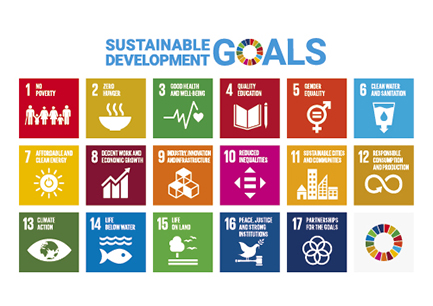
The international community has been confronted with various challenges that cross national borders such as poverty and disparity, terrorism, refugees and displaced persons, infectious diseases, natural disasters, climate change, and environmental issues. The spread of COVID-19 has dealt a severe blow to people in vulnerable situations and threatens human security. Japan has positioned the SDGs* as an important compass for overcoming these unprecedented crises and guiding the world toward a better future, and advances initiatives to achieve them.
Achieving the SDGs requires cooperation within the international community beyond the conventional concept of developed and developing countries. It also requires action not only by governments and development agencies, but also by all stakeholders, including private companies, local public entities, research institutions, civil society, and individuals. The Government of Japan provides multifaceted support by linking various initiatives using ODA as a catalyst and taking a deep approach so that the entire international community, including developing countries, can achieve the SDGs.
Voluntary National Review 2021: Report on the Implementation of the 2030 Agenda
The Government of Japan established the SDGs Promotion Headquarters, with the Prime Minister as its head and all the Cabinet Ministers as its members, and has actively worked on achieving the SDGs both in Japan and abroad through the formulation of the SDGs Implementation Guiding Principles, which sets the direction for the promotion of the SDGs, and the implementation of the SDGs Action Plan, which compiles specific policies.
The 2030 Agenda for Sustainable Development encourages UN member states to conduct regular, country-led, and country-driven voluntary national reviews (VNRs) to confirm progress on the SDGs. In July 2021, Japan presented its second VNR since 2017 to the High-level Political Forum on Sustainable Development (HLPF) held under the auspices of the United Nations Economic and Social Council. In order to achieve the SDGs, every country must develop new strategies that are not limited by past precedent, and work together to accelerate their efforts. Japan’s VNR was compiled taking into account the valuable opinions of various organizations, associations, and civil society.
Then Prime Minister Suga, who was then the Chair of the SDGs Promotion Headquarters, participated in the “SDG Moment 2021” held at the United Nations Headquarters in September. He stated that, based on its VNR, Japan would promote international cooperation and raise awareness in Japan, and do its utmost towards achieving the SDGs by 2030 and creating a hopeful future.
In addition, other international conferences and events deeply related to the SDGs were held in 2021, including the 14th UN Congress on Crime Prevention and Criminal Justice (Kyoto Congress), the Tokyo 2020 Olympic and Paralympic Games, the 26th Session of the Conference of the Parties to the UN Framework Convention on Climate Change (COP26), and the Tokyo Nutrition for Growth Summit 2021. The message sent from Japan toward achieving the SDGs attracted worldwide attention. Based on the vision, initiatives, and current status summarized in its VNR, Japan will promote efforts to achieve the SDGs by 2030 in cooperation with all stakeholders, including young people and women.
■ Improving the Trade and Investment Environment
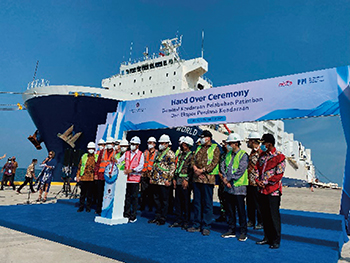
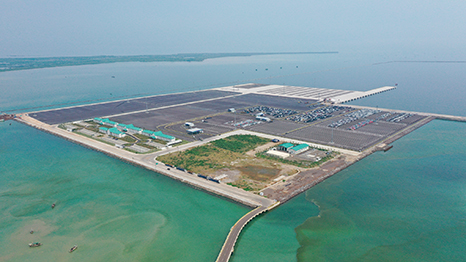
(Left photo) Ceremony featuring the handover of operation of the car terminal and the first export shipments held at Patimban Port in Indonesia, which is under construction with a Japanese ODA loan. (Right photo: Oriental Consultants Global) The current construction site of the port, including the car terminal, of which full-scale operation has begun.
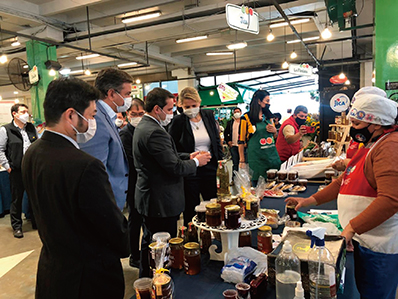
Paraguay’s then Minister of Industry and Commerce and Vice-Minister for Micro, Small and Medium Enterprises of the Ministry of Industry and Commerce visiting the “One Village, One Product” shop opened in Paraguay’s capital city Asunción by the JICA Alumni Association (Photo: JICA)
Japan utilizes ODA and Other Official Flows (OOF)* to support the development of small and medium-sized enterprises (SMEs), transfer of Japan’s industrial technology, and formulation of economic policies in developing countries. In addition, Japan supports the development of the trade and investment environment and economic infrastructures in order to enhance the export capabilities and competitiveness of developing countries.
With regard to access to the Japanese market, Japan has implemented the Generalized System of Preferences (GSP), which applies tariff rates that are lower than the general tariff to products originating from developing countries. Furthermore, for the Least Developed Countries (LDCs),* Japan applies duty-free quota-free access* by introducing a special preferential treatment. Through these schemes, Japan intends to encourage the import of products from developing countries. Moreover, Japan actively promotes Economic Partnership Agreements (EPAs)* and investment agreements. It is expected that these agreements will promote the facilitation of business environments through liberalization and protection of trade and investment, which will encourage Japanese companies to enter the markets in developing countries, and consequently, contribute to economic growth in developing countries.
Discussions regarding Aid for Trade (AfT)* have intensified in various international organizations such as the World Trade Organization (WTO) and the OECD, as a means of further promoting support from developed countries, including Japan. Japan has contributed to organizations such as the International Trade Centre (ITC), which implements AfT, with the aim to strengthen the capacity of developing countries to engage in trade negotiations and participate in the global market, and to raise their ability to implement the WTO agreements. In 2021, through the ITC, Japan provided assistance to women entrepreneurs in Africa for the utilization of e-commerce, and support for self-reliance through IT training for displaced persons in the Gaza Strip and Somalia.
Japan provides infrastructure supports such as funding for the development of transportation networks, including ports, roads, and bridges, as well as for projects to construct facilities such as power plants and power grids, all of which are vital for developing countries to engage in trade. Japan also implements technical cooperation in trade-related areas, including the training of customs officials and intellectual property rights experts. For example, in Indonesia, construction work has been underway since 2018 at Patimban Port in West Java Province under the cooperation of Japanese companies with ODA loans and technical cooperation. Public and private sector cooperation has advanced towards improving logistics and other matters, including a local company, which has been invested in by Japanese companies, that started full-scale operation of a car terminal in December 2021 (see “Stories from the Field 1” and “Stories from the Field 6” for Japan’s infrastructure assistance in Laos and Rwanda (including technical cooperation for customs staff in Rwanda), and “Project Introduction Column” for cooperation for tax officers in Kyrgyz Republic).
Regarding support for customs in developing countries, mainly ASEAN member states, among such technical cooperation, Japan has actively provided support aimed at improving the capacity of customs in developing countries through sharing of Japan’s expertise and skills in customs. Through contributions to the World Customs Organization (WCO), Japan supports capacity building activities implemented by the WCO and helps to facilitate international trade while securing safety through promoting the introduction and wider adoption of WCO tools and best practices. In addition, Japan dispatches its customs officials as JICA long-term experts to six ASEAN countries Note 4 to provide support tailored to the needs of individual fields. In Africa, under a JICA/WCO joint project, Japan provides support for strengthening border control capacity through region-wide technical cooperation projects and implements a program (the Master Trainer Programme) to train instructors who will play leading roles in customs administrations in various countries (see “Stories from the Field 6” for Japan’s support for facilitating smoother border procedures in international corridors in East Africa). The program was expanded to Pacific Island countries in 2021.
Furthermore, Japan provides assistance to small-scale production groups and small companies in developing countries over the “One Village, One Product Campaign”* (see “Project Introduction Column”). In addition, to attract private sector investment in developing countries, Japan advances support by identifying unique challenges in those countries and by offering recommendations or advice to local governments.
Timor-Leste
(1) The Project for Urgent Relocation of Ferry Terminal in Dili Port, (2) Advisor for Port Planning and Facility
(1) Grant Aid (September 2016 - January 2020), (2) Technical Cooperation (Expert) (March 2017 – March 2020)
Timor-Leste, an island country, depends heavily on imports for many of its daily necessities and port development is an important issue. The Port of Dili, the capital of Timor-Leste, is one of the country’s most important infrastructure facilities, serving as a hub for marine logistics and a port of call for ferries that transport people and daily necessities to exclave and remote islands. However, in addition to the growing volumes of cargo being handled as a result of increasing economic activity, there were no separate routes for containers and ferry passengers, which created considerable danger for passengers when boarding and disembarking from vessels.
In response to those issues, Japan has supported the relocation and maintenance of the ferry terminal through grant aid. The completion of the new passenger ferry terminal through Japanese assistance has provided separate routes for cargo and passengers, which ensures safe docking and mooring of vessels and safety of passengers when boarding and disembarking. It is expected to promote economic activity by improving access to exclave and remote islands and marine transportation capacity. It will also strengthen connectivity across the Indian Ocean and Pacific, contributing to the realization of a “Free and Open Indo-Pacific (FOIP).”
In addition, Japan has been addressing development of human resources in port maintenance. Mr. Jose Madeira Marques, vice president of the Autoridade Portuáriu Timor-Leste (APORTIL), the port authority that supervises and manages port operations in Timor-Leste, is one of the participants who studied under Japan’s human resources development program. He came to Japan as a JICA trainee in 2007 and learned the basics of ship safety for about four months. After returning to his home country, he continued to study at JICA seminars and other events. “It was Mr. Marques who asked me questions very enthusiastically from the beginning of the session. Thinking more questions would be asked in-depth during the following session, I set up time to explain in detail just for him,” said JICA senior advisor Mr. SASA Kenji,*1 who served as a lecturer at the seminars after having been dispatched as a JICA expert to the country. Following this, Mr. Marques and Mr. Sasa have cooperated on work on the port maintenance projects in Timor-Leste and played their part in leading the country’s port sector.
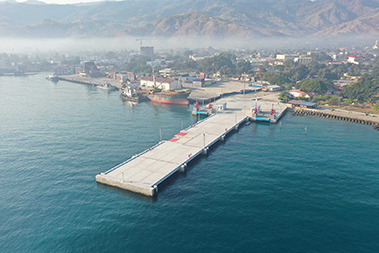
The new ferry terminal constructed through Japanese grant aid has enabled safe berthing of two ships at the same time, as well as 24-hour operation. (Photo: Tobishima Corporation)
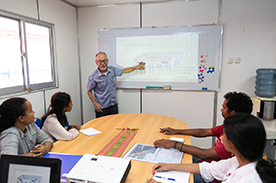
Mr. Sasa (center) (currently a JICA senior advisor) giving technical instruction to his counterparts in Timor-Leste (Photo: JICA)
*1 Title at the time of writing. His then title was JICA expert.
■ Support for Mobilization of Domestic Resources
In order to enable developing countries to achieve quality growth by resolving various development issues under their ownership, it is critical that developing countries ensure the necessary development funds in the form of tax revenue collection or others with their own capacities. This is known as “domestic resource mobilization,” and its importance has been pointed out in light of insufficient development funding for achieving the SDGs.
Japan, together with the international organizations and other entities concerned, contributes to discussions regarding domestic resource mobilization and provides relevant support to developing countries. For example, Japan proactively provides technical cooperation to developing countries for improving their tax administration. In 2021, National Tax Agency (NTA) personnel served as JICA long-term experts in Indonesia, Laos, the Philippines, Viet Nam, and elsewhere in fields including international taxation, tax audits, and taxpayer awareness raising. In addition, the NTA conducts the International Seminar on Taxation (ISTAX) and training on international taxation for Asian countries for tax officials and others from developing countries. Japan also provides cooperation on the human resources, expertise, and financing for technical assistance provided by the IMF and ADB in the field of taxation, including domestic resource mobilization, thereby contributing to strengthening capabilities in the field of taxation in developing countries, including Asia.
Furthermore, the outcomes of the OECD/G20 BEPS Project,* which was launched to prevent aggressive tax planning measures by multinational enterprises, are also important for the sustainable development of developing countries. Through the cooperation among countries to implement the outcomes of this project, developing countries will be able to respond to the tax avoidance of multinational enterprises appropriately and impose and collect tax properly in their own countries. At the same time, their tax systems and tax administration will be in line with international standards, and a stable, highly predictable, and attractive investment environment will be created for companies and investors. At present, more than 140 countries and regions, including developing countries, are participating in the framework that implements measures recommended under the BEPS Project. Under this framework, a two-pillar solution Note 5 was agreed upon in October 2021 to address the tax challenges arising from economic globalization and digitalization. Work is underway to formulate a multilateral convention and change domestic laws to implement the agreement in 2023.
■ Finance
A sound and stable financial system, coupled with smooth financial and capital markets, forms an essential foundation for the sustainable economic development of developing countries. As financial globalization advances, it is pivotal that financial systems in emerging countries are properly established and that assistance is provided for the development of sound financial markets.
Based on this concept, the Financial Services Agency conducted the “Seminar on Improvement of Banking/Securities/Insurance Supervision” for emerging countries on the regulatory and supervisory systems and initiatives of Japan’s financial and capital markets. Specifically, a seminar on insurance supervision was held in February 2021, a seminar on securities supervision was held from February to March, and a seminar on banking supervision was held in September. Each seminar was held in an online format, with a total of 43 participants from 13 countries. Another seminar on securities supervision was also implemented in an on-demand format Note 6 from October to December.
Glossary
- Quality Infrastructure
- Infrastructure that genuinely contributes to “quality growth” and is “resilient” against natural disasters and other risks, “inclusive” so that no one is left behind, and “sustainable” taking into account its impact on society and the environment. The “G20 Principles for Quality Infrastructure Investment,” which incorporate key elements for investing in “quality infrastructure” such as (i) openness, (ii) transparency, (iii) economic efficiency in terms of life-cycle costs, and (iv) debt sustainability, were endorsed at the Osaka Summit in June 2019.
- Sustainable Development Goals (SDGs)
- International goals aimed at a sustainable and better world by 2030, as described in the 2030 Agenda for Sustainable Development adopted by all UN member states at the UN Summit in September 2015 as the successor to the Millennium Development Goals (MDGs, 2001). The SDGs consist of 17 goals and 169 targets.
- Other Official Flows (OOF)
- OOF refers to flows of funds to developing countries from governments, which are not considered as ODA because their main purpose is not development, the leniency of their conditions does not reach the standards, and/or other reasons. Examples include export credit, direct investment by governmental financial institutions, and financing to international organizations.
- Least Developed Countries (LDCs)
- According to the classification by the UN, LDCs are countries particularly behind in development compared to other developing countries based on their income levels. LDCs meet certain criteria, including gross national income (GNI) per capita of $1,018 or less on average between 2017 and 2019. As of 2020, there are 46 eligible countries: 7 in Asia, 2 in the Middle East, 33 in Africa, 1 in Latin America, and 3 in Oceania.
- Duty-free quota-free access
- A measure to make products imported from LDCs tariff free and without any import quotas. Japan has been expanding the number of applicable products under this measure, and approximately 98% of all products can be imported under such conditions.
- Economic Partnership Agreement (EPA)
- EPAs are agreements for strengthening a wide range of economic relations, incorporating not only elements of Free Trade Agreements (FTAs) that are aimed at reducing and eliminating tariffs on goods and barriers to trade in services between specific countries and regions, but also elements of cooperation in various sectors such as investment, movement of persons, protection of intellectual property, and rulemaking on competition policy. These agreements are expected to further vitalize trade and investment between countries and accelerate economic growth.
- Aid for Trade (AfT)
- AfT is an assistance provided to developing countries to improve trade-related capabilities and to develop infrastructure for the purpose of achieving economic growth and poverty reduction through trade in developing countries under the WTO’s multilateral trading system. The WTO emphasizes the significance of promoting the development of developing countries through their participation in the multilateral free trading system.
- One Village, One Product Campaign
- The One Village, One Product Campaign is an initiative, which was launched in Oita Prefecture, Japan in 1979 and prevails globally, that aims to create jobs and to revitalize local communities through promoting unique products that take advantage of local resources and traditional techniques. In Asia and Africa, this Campaign facilitates expanding exports of developing countries’ products by discovering attractive goods, such as handcrafts, textiles, and toys that represent the unique ethnic characteristics of those countries and by reaching out to a wider range of people.
- OECD/G20 BEPS Project
- Base Erosion and Profit Shifting (BEPS) refers to the issue of multinational enterprises’ aggressive tax planning measures that exploit gaps and loopholes in international tax systems, including tax treaties, in order to intentionally reduce the tax burden for economic activities that should have been taxed. In order to address this issue, the BEPS Project was launched in June 2012 by the OECD’s Committee on Fiscal Affairs, with the aim of ensuring fair competition and making international taxation rules conform with the situation of the global economy and company trends, as well as reviewing international taxation rules across the board in order to raise transparency among all governments and global companies.
- Note 1: Growth that is “inclusive” in that the fruits of growth are shared within society as a whole, leaving no one behind, “sustainable” in that it can be sustained while being in harmony with society and the environment, and “resilient” in that it is able to withstand and recover from economic crises, natural disasters, and other shocks (Development Cooperation Charter).
- Note 2: Forecasts by the G20 Global Infrastructure Hub (GIH).
- Note 3: See the glossary “Quality Infrastructure”
- Note 4: The six countries are: Cambodia, the Philippines, Malaysia, Myanmar, Laos, and Thailand.
- Note 5: Pillar One is a revision of international taxation principles to allow the taxation of global corporations with large scale and high profit levels in market countries regardless of whether they have a physical presence there. Pillar Two is the introduction of a global minimum tax rate from the perspective of curbing the competition to lower corporate income taxes.
- Note 6: A streaming format in which video training materials that have been filmed and edited in advance are uploaded to a streaming server or other forms of distribution, and participants can take the seminar at anytime they wish.
